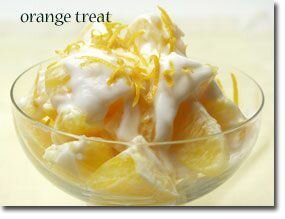Today's Recipe
If you don't know what to serve for dessert tonight ...
Try this tangy dessert tonight. One serving contains just 81 calories!
10-Minute Orange Treat

Prep and Cook Time: 10 minutes
Ingredients:
- 1/2 tsp grated lemon rind*
- 1/2 TBS fresh lemon juice
- 2 TBS honey
- 2-1/2 TBS low-fat yogurt
- 2 medium oranges
- Optional: Top with orange zest
- In a small bowl, whisk lemon rind, lemon juice and honey until the honey is incorporated.
- Add yogurt and whisk thoroughly.
- Peel and separate the individual sections of the orange. Be sure to remove the membrane covering from each section. Cut the sections into thirds crosswise. Place in 2 dessert bowls.
- Spoon sauce over the oranges.
Serves 2
Printer Friendly Version of 10-Minute Orange Treat
In-Depth Nutritional Profile for 10-Minute Orange Treat
Healthy Food Tip
Can you tell me more about pasteurization and whether I should consider buying unpasteurized (raw) milk?
The Pasteurized Milk Ordinance (PMO) that was first proposed in 1924 by the United States Public Health Service has been adopted, in its 2003 revision, by 46 out of 50 states. (The four non-adopting states have passed similar ordinances of their own.) The PMO calls for the pasteurization of milk as a way of killing any potentially disease-causing bacteria in the milk, including Campylobacter, Escherichia, Listeria, Salmonella, Yersinia, and Brucella. I would also like to note that in 32 states, it is legal to sell and distribute raw, non-pasteurized milk and that both forms of milk exist in the majority of states.
Today there are more pasteurization options in the marketplace than there were in 1924; these options include high-temperature, short-time methods as well as low-temperature, longer time methods. The goal of all methods is the same: to kill potentially pathogenic bacteria that may be present in the milk or milk product (like cheese or yogurt).
| Temperature | Time | Pasteurization Type |
|---|---|---|
| 63°C (145°F)* | 30 minutes | Vat Pasteurization |
| 72°C (161°F)* | 15 seconds | High temperature short time Pasteurization (HTST) |
| 89°C (191°F) | 1.0 second | Ultra Pasteurization (UP) |
| 90°C (194°F) | 0.5 seconds | Ultra Pasteurization (UP) |
| 94°C (201°F) | 0.1 seconds | Ultra Pasteurization (UP) |
| 96°C (204°F) | 0.05 seconds | Ultra Pasteurization (UP) |
| 100°C (212°F) | 0.01 seconds | Ultra Pasteurization (UP) |
| 138°C (280°F) | 2.0 seconds | Ultra-high temperature (UHT) sterilization |
There's no debate about the effectiveness of pasteurization for killing unwanted bacteria. There's also no doubt that pasteurization gives dairy products a longer shelf life by lowering the presence of bacteria that cause spoilage. But pasteurization also kills desirable bacteria found in fresh milk, and it denatures milk enzymes that may be active in the human digestive tract when fresh milk is consumed.
There is little research, however, to determine what nutritional benefits are lost when milk is pasteurized. I've seen speculation about changes in protein structure, calcium, amino acid, and vitamin C bioavailability all being triggered by pasteurization, but I have not seen research that confirms or rejects these occurrences.
As I mentioned earlier, in the majority of states, dairy farms are free to produce raw (unpasteurized) milk as long as they adhere to the conditions and restrictions set out in state law. The safety of unpasteurized milk depends on the quality of the cow's life,
including the immediate environment and feeding. It also depends on the quality of handling facilities once the cow has been milked. For these reasons, I recommend a very careful look at any dairy farm's procedures, track record, and publicly available information before becoming a regular consumer of its unpasteurized milk. Producers of raw milk should be carefully monitoring the milk for the presence of microorganisms and will be able to certify that the milk meets all federal and state regulations in this regard.
Because freshness is at a premium, and the product shelf life is greatly shortened (which is not necessarily bad) the dairy should be within driving distance of your residence so you can visit it in person. In some states, like Indiana, where it is illegal for a local dairy to sell unpasteurized milk, cows from the dairy may be leased in order for consumers to obtain a regular supply of raw milk.
In the absence of a very high-quality dairy farm in driving distance from your residence, I recommend purchase of pasteurized milk. Even though it's one step further from natural milk (which I would prefer), the health risks, however small, don't seem like a worthwhile trade-off in exchange for the potential benefits. If a high quality dairy farm, producing certified organic milk in unpasteurized form is available in your area, I would recommend considering this option.



No comments:
Post a Comment